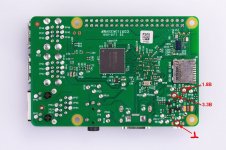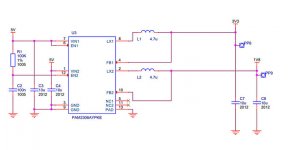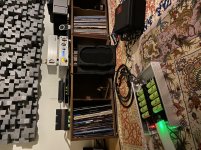For 5V pi power, you would need two lifePO4's in series at 2.5V each. This isn't optimal for a lifepo4, they really want to be running at 3.3V.
For 5V pi power, you would need two lifePO4's in series at 2.5V each. This isn't optimal for a lifepo4, they really want to be running at 3.3V.
LifePO4 cells can not keep 2.5V. The voltage will be always stay around 3.3V, that's decided by chemical.
Battery cells are different from capacitors.
Ian
LifePO4 cells can not keep 2.5V. The voltage will be always stay around 3.3V, that's decided by chemical.
Battery cells are different from capacitors.
Ian
You have to supply regulated 2.5V to each cell, so its not easy and not optimal.
Hello averyone!
Somebody made compare A123 batteries with other brands (26650) for use in LifePo4 power supply?
prohvesor is wondering what's the difference between A123 LifePO4 battery cells and other brand cells?
Is there any body has this experience?
Ian
prohvesor is wondering what's the difference between A123 LifePO4 battery cells and other brand cells?
Is there any body has this experience?
Ian
It was a good many months ago that I made a comparison, but the biggest meaningful difference I saw was in the specified output impedance, they are not all the same, many with a far higher output impedance than the A123 spec of 6mΩ.
They can also have a lower maximum continuous output current rating, the A123 spec'd at 50 amps, many are lower.
The ones with lower ratings on the above sometimes also then have a higher Ah rating, so they trade the above for slightly better endurance.
There could be other differences too, including just the overall quality, but the above are easy to see in the specs.
The A123 batteries are no longer branded that way everyplace in the world, the parent company now known as Lithiumwerks after the merger with Valence.
So the exact same battery is now also branded Lithiumwerks in at least some parts of the world.

ANR26650M1-B, A123 Nanophosphate(R) 3.3V 2.5Ah Lithium Iron Phosphate (LiFePO4) Cylindrical Battery
Last edited:
As far as I understand, the older battery has greater internal resistance.
So, probably, for audio we can use any 26650 and it doesn’t affect on sound.
Has anyone measured, is 26650 have at least the slightest noise or are they absolutely quiet?
So, probably, for audio we can use any 26650 and it doesn’t affect on sound.
Has anyone measured, is 26650 have at least the slightest noise or are they absolutely quiet?
As far as I understand, the older battery has greater internal resistance.
One correction to my post above, I stated "output impedance" when I meant to just say impedance.
Ian will be Uconditioner accu or powercap design or just regulator? I think a lot how to make 5..5,5v accu power supply for usb bridge signature...
Page 10 in the manual states that power supply will turn of automatically when J1 and J2 is lower than given threshold.
Can I assume this also applies to J3 and J4 from over discharge?
Im setting up to use J3 and J4 at 13.2v, J1 and J2 is unused so they will always monitor fully charged. Do I need to involve J1 and J2 in any way or can they remain unconnected?
Can I assume this also applies to J3 and J4 from over discharge?
Im setting up to use J3 and J4 at 13.2v, J1 and J2 is unused so they will always monitor fully charged. Do I need to involve J1 and J2 in any way or can they remain unconnected?
How many years have you been designing battery chargers? Did you know that batteries generate noise from the chemical processes? Are there any voltage regulators used in the equipment you are powering or do you by-pass them all? Any idea what a fault current on your expensive equipment will cause. Did you know battery temperatures makes a difference in both charge and discharge process to the battery. Be very careful when selling the stuff. If your charger burns down a house, then you better have insurance available.
HI Kasra,
I noticed you have an Aries on the audio shelf. It accepts 16V/1A but handles down to 12V. Have you tried powering it with the battery PCB? If so, any improvement?
Martin.
I noticed you have an Aries on the audio shelf. It accepts 16V/1A but handles down to 12V. Have you tried powering it with the battery PCB? If so, any improvement?
Martin.
Looks great Ian, Keep it up!
HI Kasra,
I noticed you have an Aries on the audio shelf. It accepts 16V/1A but handles down to 12V. Have you tried powering it with the battery PCB? If so, any improvement?
Martin.
Hi Martin,
No I have just made trial runs with my preamp. I know the auralic benefits alot from cleaner power. Therefore I would assume that there should be an improvement.
/kasra
Thanks for the reply Kasra. I have a couple of Ian's boards coming so will give it a try.
Martin.
Martin.
Hi Ian,
UcConditioner V3.0 can be use with standard 3.3V regulators ?
What would be the constraints of use (maximum output current on regulator, ...)
nounouchet
UcConditioner V3.0 can be use with standard 3.3V regulators ?
What would be the constraints of use (maximum output current on regulator, ...)
nounouchet
Ian, ucConditioner is a very good solution, but the rpi board still has a dc controller that gives noise. Perhaps it will be a great solution to unsolder it and apply clean 1.8, 3.3, 5.0V to rpi? How do you think?


https://www.diodes.com/assets/Datasheets/PAM2306.pdf


https://www.diodes.com/assets/Datasheets/PAM2306.pdf
Last edited:
@prohvesor
I'm also working on another new project which is ConditionerPi.
ConditionerPi will be plugged on top of a RPi to provide a local ultra capacitors conditioning to RPi mian 5V rail.
UcConditioner is part of power supply, while ConditionerPi will be part of local RPi. ConditionerPi will be suitable for most of RPi audio applications to improve quality the power supply right away. Those light weight RPi audio application will be benefit especially because the quality of power supply normally is not as good as the fully equipped applications. However, CconditionerPi and UcConditioner can also work together at both local and exteranl to make more improvement.
But for 3.3V rail and 1.8V rail, things could be difficult.
Regards,
Ian
I'm also working on another new project which is ConditionerPi.
ConditionerPi will be plugged on top of a RPi to provide a local ultra capacitors conditioning to RPi mian 5V rail.
UcConditioner is part of power supply, while ConditionerPi will be part of local RPi. ConditionerPi will be suitable for most of RPi audio applications to improve quality the power supply right away. Those light weight RPi audio application will be benefit especially because the quality of power supply normally is not as good as the fully equipped applications. However, CconditionerPi and UcConditioner can also work together at both local and exteranl to make more improvement.
But for 3.3V rail and 1.8V rail, things could be difficult.
Regards,
Ian
- Home
- Amplifiers
- Power Supplies
- Develop ultra capacitor power supply and LiFePO4 battery power supply


